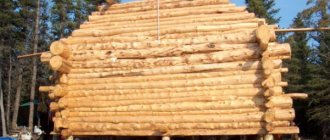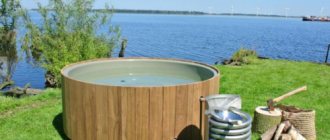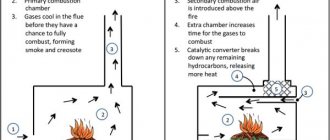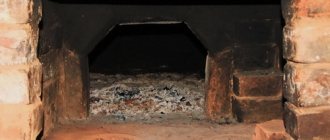How to make a sauna stove with your own hands - details from the master
The design of the stove is primitive, but has a number of significant conditions.
The difference between an ordinary heating stove and a sauna is that the second one contains additional elements, such as a heater and a water tank. Many craftsmen opt for making a bathhouse stove with their own hands, without buying it in a store. The construction process is not simple and requires a lot of time.
First you need to familiarize yourself with the main components of sauna stoves, and these are:
- material;
- energy carrier used;
- firebox location;
- heater heating system.
Why cast iron and not steel?
All branded stoves “A” are made of cast iron grade ChH-1 (with the addition of chromium). Thanks to its porous (loose) structure, the alloy retains heat better than steel, and is optimally suited for sauna stoves. Their efficiency reaches 82-85% - much higher than that of brick and steel structures. The advantages of cast iron stoves also include:
- Improved fire safety. Cracks do not form in cast iron under strong heating, which completely eliminates the risk of sparks leaving the furnace;
- Durability. Cast iron stoves are designed to last at least 30-35 years;
- Corrosion protection. The cast iron heating stove is not afraid of moisture and dampness, and can be kept in the steam room for as long as desired;
- Exquisite appearance. Gray cast iron combines beautifully with metal, stone, wood and glass, and can decorate the interior.
Another argument in favor of purchasing a cast iron stove for a sauna is the duration of combustion/smoldering of the fuel. So, one stack of firewood will be enough for at least 3-4 hours. All this time you can relax calmly in the bathhouse, without disturbing your leisure time by constantly running to the firebox and back.
Types of fuel and types of stoves
Bathhouse stoves are divided into 2 main groups: metal (cast iron) and brick options. Brick sauna stoves are heat-intensive; they take longer to heat up, but also take a long time to cool down. An iron stove is an economical heating item due to its multitasking, simplicity and convenience of equipment. When choosing a stove or fireplace, you need to look not only at the design of the heat source, but also at the type of fuel. When burning the same mass, different fuels will release different amounts of heat. There are many variations of the energy carrier.
According to the aggregate content and type of fuel, all fuel groups are divided into solid, liquid and gaseous fuels. Solid is a common class of fuel, it includes: coal, peat, briquettes, firewood, pallets. They are used only in ordinary ovens as they burn quickly. Liquid fuels are kerosene, fuel oil, diesel, boiler, and coke liquid.
They have significant calorific value. The first type of gaseous fuel is natural gas, obtained from gas reservoirs, or associated gas from naphtha production. It has good calorific value.
Positive and negative qualities of metal sauna stoves
There cannot be a steam room without a stove, because it is it that heats the room and maintains the desired temperature. Nowadays you can find a wide range of different options. But it’s best to make the oven yourself.
The advantages of a metal device include:
- actions are carried out quickly, and at the same time not very expensive, this can be done autonomously with basic knowledge and experience;
- a significant part of the models are compact, so they are suitable for small saunas;
- rapid heating of the steam room to the required temperature, even in winter;
- the mechanism can last a long time, it all depends on the welding condition and the thickness of the metal;
- economical fuel consumption;
- easy to use, even a person who does not have the proper skills can handle it.
An iron stove has negative qualities, these are:
- low heat capacity, it is not enough to heat the rest room;
- excessively rapid cooling, so you need to heat it regularly;
- the walls heat up and nearby objects can catch fire.
It is not easy to determine which stove is best for a bath; there are a lot of design qualities.
Main advantages
A metal heater has several important advantages compared to its brick or stone counterpart:
- Compactness. Its dimensions are quite small, which allows installation in confined spaces. When using suitable finishing materials, such stove equipment fits perfectly and complements the interior.
- Durability. Metal heaters have a long service life. The material can withstand repeated expansion due to temperature changes.
- Reliability. With careful use, metal heaters will last for a long time without maintenance or repair.
- Easy to install. There is no need to perform complex masonry, carefully prepare the room, or take care of thermal insulation. All you need is a little time. After all, with some skill, you can install the heater yourself.
- Availability. Inexpensive wood-burning sauna stoves made of metal are more affordable than their stone and brick counterparts. At the same time, modern metal models are not inferior in attractiveness.
- Fast warm-up. A traditional stone or brick oven takes a long time to heat up. The average heating time for a metal furnace is about 1.5 hours. Because A metal heater has good heat transfer, warming up the steam room much faster.
Construction of metal furnaces
Metal is a more malleable material than ceramics; it can be melted and cast, drilled, cut, bent, and forged. There is a considerable amount of metal processing. Basically, when making a stove with your own hands from metal, you need to focus on its quality. The metals used for the production of the heating mechanism are: ordinary steel, heat-resistant variations of steel, surrogates and cast iron.
The second step will be to create a stove and choose the type of its design. The dressing comes in different forms, the main thing is to follow the joining technology. For this, there are diagrams where the structural properties of all elements are depicted in detail. It can be created with an open or covered heater. Carefully take into account the dimensions of the bath itself. The elementary design should consist of a water tank and a firebox, and definitely have a tube, a rod and a grate.
It should also have strong latches. To remove the results of combustion, it is advisable that the stove be equipped with a chimney pipe. And also a tap that will be mounted on a water tank. Not all stoves look harmonious in the interior of the house; this problem can be solved by removing the portal for the sauna stove with your own hands.
Differences between metal stoves for baths and saunas
Steam rooms in a sauna and a bathhouse have impressive differences, these are the temperature and dryness of the air. In the bathhouse, the temperature varies from 50 to 70 degrees, resulting in the formation of soft steam. The temperature in the sauna is above 85 degrees Celsius, the steam comes out dry. To create certain conditions in the steam room, different stoves and various approaches to their installation are used.
To build a sauna, it is necessary to maintain maximum contact between the stove shell and air in order to ensure rapid circulation of air flows along the walls.
It all comes down to heating the air faster. In the bathhouse, the microclimate is organized in a different way, where a high temperature is reached and a lot of steam is generated. To achieve the effects, stones are placed in a firebox, that is, in a closed heater. A small heater is placed above the firebox, which helps heat the stones to 250 degrees Celsius.
The next difference is that metal sauna stoves are convection, and all baths are organized in such a way as to avoid thermal convection without any trace. Convection in the usual syllable is the movement of air inside a room.
Do-it-yourself stoves for Russian baths
The current Russian bathhouse is a small house made of timber or logs. Inside, as a rule, there is a division into 2 rooms, namely a dressing room and a steam room. A stove for a Russian bath is not just a heating mechanism, it is its most important accessory. The temperature, dryness and heating level of the steam room depend on it. There are many categories of sauna stoves.
But not everyone is suitable for a Russian bath. The fundamental difference will be warming the air to a temperature of 65 degrees Celsius, while creating steam between 60 and 80 percent. As a result, so-called weak steam is formed in the steam room.
This is a pleasant, moderately or almost non-burning velvety steam. In a true Russian bath you can breathe nicely and simply, and your skin will not experience severe thermal stress.
Often a brick or steel stove is installed in a bathhouse. All these materials heat up well and transfer heat well to the room. There are no stamps for the construction of stoves; only the general principles of architecture and construction are observed.
Brief description and dimensions of the metal stove
An iron sauna stove can effectively heat small rooms. It is created by a covered, open and combined design. The mechanism has a tank for heating water and a heater built into the upper part of the stove. The closed device consists of 3 compartments, this is a chamber with a blower, a heater and a hole for steam outlet, and a tank for heating water.
An open-type installation has a metal grate on which stones are placed, which is located above the combustion chamber. There are no barriers between the firebox and the stones. Combined devices of this group are distinguished from others by the presence of an enlarged combustion chamber, equipped with double bolts and grates.
Fire from all edges heats the heater, and this significantly increases the productivity of the stove. The volume of the oven varies; during its construction, the parameters of the steam room and the number of people washing in it are taken into account.
The size of the heating system depends on the strength of the heating system. The higher the coefficient, the more fuel needs to be burned. For ideal air heating, the parameters of a sauna stove must be as follows: the ratio of the size of the firebox to the area of the heated room is 1:50 or 1:70, the depth of the firebox opening is 1:2 or 2:3, and the volume of the firebox to the cross-section of the chimney should be in proportion 1: 10.
A heat exchanger for a sauna stove is a technical unit that heats the incoming liquid and then transfers it to a hanging container.
Design features of a metal furnace firebox
The furnace firebox is the most important element of any hearth. It sets the characteristics of the furnace, since the heating speed and the quality of the steam produced depend on it. A firebox or firebox is a device for burning organic fuel. Fireboxes are made from different materials, are designed for different types of fuel, and have different sizes.
A metal or ready-made furnace firebox is a high-tech device that is more economical in fuel consumption. Its efficiency depends on proper design.
The classic firebox for sauna stoves consists of the following basic elements:
- front is the front part of the combustion space where the loading door is located;
- the head wall, where, depending on the furnace mechanism, an outlet window for removing flue gases may be located;
- the arch of the firebox or ceiling where the exit window is located;
- sole - the lower horizontal part of a closed combustion volume.
It can be internal, located directly inside the furnace, or external, this is a tunnel passage; fuel can be loaded from another room.
What are metal sauna stoves made of?
An iron sauna stove is a classic version of long-burning with a water outline. The device consists of a sealed metal box equipped with a combustion door and an exhaust pipe.
To produce metal sauna stoves with your own hands, you will need raw materials and parts:
- a steel sheet with a thickness of approximately 8 millimeters;
- doors for the firebox, blower and heater;
- tap water;
- grate;
- chimney pipe.
When carrying out the equipment, it is necessary to use thick metal, so the device will predominantly generate heat when heated.
Cost of a wood-burning stove for a sauna
The total cost of a metal heater depends on its size, weight, and the volume of the steam room. To choose the appropriate furnace equipment for the bath, you need to pay attention to its power. Even a slight discrepancy between this characteristic and the total volume of the steam room can cause incomplete heating or, conversely, overheating, as a result of which the procedures will not bring the maximum effect. If necessary, it makes sense to use the recommendations of specialists.
You can buy a stove for a Russian wood-burning bath at. We cooperate directly with manufacturers, which allows us to set low prices for our products. Our specialists, having studied your requirements and budget, will choose the optimal solution that will suit you in all respects. They will also carry out delivery, installation and commissioning in compliance with deadlines and all fire safety requirements.
Regardless of the budget and complexity of the project, we will make your dreams come true by building and equipping a steam room taking into account all your wishes.
Making a furnace firebox for a bathhouse from metal
The installation of the firebox must be carried out in accordance with all standards. The foundation for the firebox is a very important element. The reliability of the base determines the duration of its use, which can range from several months to decades. The firebox itself does not look quite aesthetically pleasing, so it is decorated with fireplace tiles. There are a lot of variations on how to make a firebox for a bath.
For the frame you will need a sheet of steel with a thickness of at least two millimeters; you can also use a chylous barrel, but with additional fastening. The sheet is divided into several sections for the firebox, tank and heater.
The remainder will be needed to make the ash pan and door. Corners or plates will be welded along the length where the grate will rest. It is best to purchase it in a store.
Making a heater
This type of stove is called a heater because it consists of individual stones. When fuel burns, the stones heat up, and the water that ends up on them forms steam. First of all, you need to choose the design and dimensions of the mechanism for heating the water. For the heater, the rods are attached by welding. Since it is heavy, the rods or square must be at least 10 millimeters.
A door is cut into the heater to transfer water to the stones. In this case, the heater door must face into the steam room, and the firebox must be placed opposite the entrance. The stones are distributed into the heater with some clearance, not closely. It is a good idea to use stones with small crystals of small size. It can be diabase or just chlorite.
Stones containing mica are prohibited; it promotes the release of carbon monoxide, and this is harmful to life. You need to attach a metal chimney cover above the heater, and then install a water tank.
Creating a tank for heating water
The most practical method of heating water in a bathhouse is to use heat from the stove. There are several ways to install a tank for a sauna stove, the main thing is the location of the tank, it can be: internal, mounted or remote.
To design the tank, three versions of the material are used: cast iron, stainless steel containers or stainless steel. To make an iron barrel, you need to carry out a number of actions.
First you need to cut the desired piece of pipe. The cutting areas must be carefully processed. Then you need to start installing the bottom and top lid of the container. The next stage is soldering all the cut parts. Afterwards you need to install a tap and pipes, as well as a heat exchanger for the sauna stove. Then the installation of the module is carried out.
Assembling a sauna stove with your own hands from metal
They prefer to build the stove supply for the bath separately. This is due to the fact that it is possible to create exactly the model of the stove that you wanted. Then, to make a metal sauna stove with your own hands, you will need blueprint reading skills, construction tools and materials. First you need to draw up a project and determine the dimensions of the device.
There are 2 design options for homemade stoves, these are the horizontal and vertical versions. To make a stove you will need:
- a rod ten millimeters thick;
- sheet steel, 8 mm thick;
- iron pipe;
- latches;
- water tap;
- two meters of pipe.
We take a large piece of pipe and cut out an opening in it for the blower. In the middle of the pipe, on the side of the opening, we weld fastenings for the grate. Then we equip the firebox, for this we weld fastenings for the heater rods. On the back side of the heater we cut a hole through which steam will flow. We fill it with stones suitable for this type of unit.
We cut a hole in the roof for the stove for the chimney pipe and install it. And don’t forget to cover the sauna stove with useful material to create a classic stove. It’s not difficult to build the device; just follow the instructions.
Necessary equipment for work
Installing a sauna stove is an important matter, the correct operation of which depends on the correct organization of the installation. Initially, you should choose a place to place it. It is also necessary to adhere to fire safety rules.
According to standards, the distance between the stove and a flammable wall must be at least 25 centimeters. First you need to determine what kind of stove you decide to install. The next stage is drawing up a plan and counting the necessary material.
To assemble a homemade stove, you will need tools: a grinder, metal scissors, a welding machine, a variety of measuring and marking kits. You will also need material. The step-by-step manufacturing process can be seen in the video presented in this article.
Making a heater stove for a bath from a metal pipe
A do-it-yourself sauna stove made from a pipe is the easiest and most economical option for furnishing a room. A similar design will work well in every room. Thanks to the sealed housing, the stove made from 530 pipe will not emit carbon monoxide when active, so it is completely safe. A pipe bath can be made in two types: a horizontal and a vertical model.
This type of furnace significantly reduces the number of welding steps. In order to obtain an improved stove, only high-quality tubes are used, without corrosion. The workpiece should be cut into two parts, a longer section is needed for making a firebox and heater, and the remaining piece is suitable for constructing a tank. First you need to start making a pod.
A hole is cut at the bottom of the pipe, and a strong round-shaped plate is welded above it. Then we make a firebox and a door for it. We hang the door on a loop or hooks. A piece of pipe is welded above the firebox, which will be used as a heater.
Material for a metal stove in a bathhouse
Making stoves is an interesting and labor-intensive procedure. There are many types of metal stove models. The main task is to create a structure that is strong enough to prevent deformation and high thermal conductivity. For the manufacture of the mechanism, different materials are used: cast iron, steel and heat-resistant steel. The most common manufacture is steel.
This matter tolerates temperatures up to 400 degrees. The thickness of steel starts from 4 millimeters, but the disadvantage of the material is that it quickly burns out. The next material used is heat-resistant steel.
The minimum metal thickness is 3 millimeters. The stoves are made from the safest material, efficient and easy to install. Another material for forming metal sauna stoves is cast iron. It is not inferior in strength to steel, but at the same time its heat capacity and fragility are comparable to ceramics.
Installing a stove in a bathhouse
Precisely installing a stove in a bathhouse with your own hands is a responsible procedure, since the comfort and safety of its operation will depend on this.
In order for the steam room to warm up effectively, you need to select the location of the stove structure. By following all the rules and regulations for the placement of the heating medium, you will not have to worry about altering the bath unit for many years.
First of all, you need to calculate the dimensions of the device for the size of the high-temperature room, because the roof and interior decoration can burn, smolder, or melt; to prevent this, you need to choose the correct placement of the stove. You should also take care of installing a hood for a sauna stove, and do it yourself. It should be placed 50 centimeters from the wooden covering.
If it is protected by a metal screen, the distance can be reduced. The partitions opposite the firebox may not be insulated. The gap from the ceiling to the top cover should be 1.5 meters.
There must be unhindered access to the elements of the furnace structure in case of an emergency. You also need to plan in detail the ventilation system in the steam room, and think about the release of combustion products. When installing a brick kiln, you need to create a solid foundation, and place light metal structures on a non-combustible floor base.
Popular makes and models
In order to choose a stove that suits the characteristics of the room and the needs of the owner, it is necessary to take into account its operating qualities. However, you need to know the most famous manufacturers of such products. This will help to immediately cut off products from various nameless companies, the quality and durability of which are very questionable.
Let's consider several models of metal stoves from popular and reliable manufacturers.
Cast iron stoves:
Hephaestus PB-04 MS
Compact oven of domestic production. Design with an open heater, remote firebox, power 12 kW (for rooms up to 15 m3).
- Advantages : high efficiency, attractive design, presence of a secondary fuel combustion system.
- Disadvantages - long heating time and heavy weight;
VESUVIUS Legend Standard 16
The oven is equipped with a protective grille that provides protection against burns. The maximum volume of the steam room is 18 m3, weight is 92 kg.
- Advantages : thoughtful design, safety for users, reliability.
- Disadvantages - no water tank, rather large size;
NARVI Oy Kota Inari
Finnish cast iron stove, designed to heat a room up to 16 m3.
- Advantages : compactness, glass door, fuel afterburning system.
- Disadvantages - the size of the heater is small.
Steel furnaces:
Anapa
Products of the Russian company Izistim, made of heat-resistant stainless steel (thickness 5 mm). The body is bent-welded, which eliminates the possibility of temperature deformations. The manufacturer can custom line the stove with natural stone - soapstone or coil. Closed heater, weight of stones - 55 kg.
- Advantages - a comfortable long firebox (logs up to 45 cm can be used), a door with glass, high power (30 kW).
- Disadvantages - quite high fuel consumption.
Angara 2012
Products of the domestic company Termofor. The stove is made of heat-resistant low-alloy steel (chrome content - 16%). Equipped with a built-in heat exchanger. Room volume - up to 18 m3. It has two heaters - internal (33 kg) and external (30 kg).
- Advantages : high efficiency, power, practicality, affordable cost.
- Disadvantages : door without glass.
Vesuvius Russian steam
This is a whole model line of steel furnaces with different capacities and designed to heat rooms from 9 to 32 m3. The open heater is housed in a basket made of steel strips, while models with a closed heater are housed in a barrel-shaped casing.
- Advantages : practicality, power, durability.
- Disadvantages - there is no water tank.
Gas ovens:
Uralochka 24
Floor-standing heater designed for heating rooms up to 24 m3. The model is universal; you can use wood instead of gas. It is equipped with a burner, control unit, and piezo ignition system. You can use additional options - a water tank, a steam generator, a convector screen.
- Advantages : universal fuel type, reliability, high power.
- Disadvantages - large dimensions.
Rus 18 LKGD
Another gas-wood stove from domestic manufacturers. The stove is safe and very economical - gas consumption in maximum mode is only 1.5 m3/hour.
- Advantages : it is equipped with a water heating function, maintains a balance of temperature and humidity, and is highly reliable.
- Disadvantages - the oven is large and heavy.
TMF Urengoy Inox TSB
Gas stove designed for wall installation in a bathhouse with a volume of up to 12 m3.
- Advantages : relatively low price, low gas consumption, compact size.
- Disadvantages - it is not equipped with gas fittings.
Only the most popular models of metal stoves are considered. There are many more of them on sale; users can choose the optimal sample for themselves.











